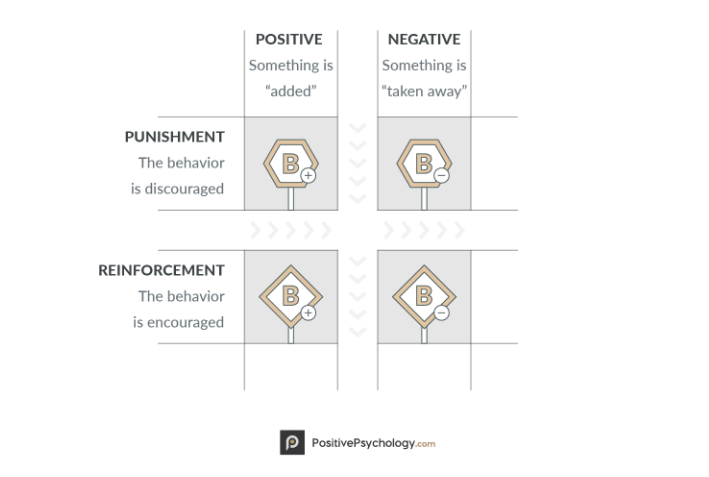Reinforcement And Punishment, Negative And Positive: What’s The Difference And Which One Should You Use?
21 April 2020

Positive reinforcement changes behavior for the better, while criticism stabilizes negative behaviors and blocks change.
(Virginia H. Pearce)
Many people confuse positive and negative reinforcement and think the latter is synonymous with punishment. However, there is actually more art to it than that. And when used appropriately it can do wonders for employee motivation and engagement.

Positive reinforcement doesn’t just mean lavishing praise on someone and negative reinforcement doesn’t mean scolding a person. “Positive” and “negative” mean totally different things in the fascinating science of operant conditioning, which is actually a science of analyzing and modifying human behavior.
So, as we are talking about human behavior, simply put, we want some types of behavior to occur more often and other types – less often. Say, you want employees to show initiative on more occasions and be lazy less often. Thus, you want to reinforce, i.e. strengthen, the first type of behavior and weaken the second type. This is where the general notions of reinforcement and punishment come into the picture. Reinforcement is being used to increase the probability of target behavior to occur, and punishment is being used to decrease that probability.

Now, there are also different ways you can increase or decrease that probability and that’s exactly where “positive” and “negative” terms come into play. Introduction of the stimuli is positive reinforcement or punishment, and removal of the stimuli is negative. So, let’s take a workplace example: if you have an employee who’s always late and you tell that employee that with every time said employee is late the likelihood of him getting a raise diminishes – that’ll be an example of negative punishment usage (negative because you’re removing something). Or perhaps, you decide to give him some additional tasks that are trivial and boring, in that case that will be a positive punishment (positive, because you are adding something).

So, to sum up the definitions:
Positive reinforcement – when stimuli presented after a target behavior are rewarding and aimed at strengthening that behavior;
Negative reinforcement – when aversive stimuli are removed in order to strengthen the target behavior;
Positive punishment – when aversive stimuli are presented after a target behavior and the aim is to decrease the occurrence of that behavior;
Negative punishment – when pleasant stimuli are removed after a target behavior and the aim is to decrease the occurrence of that behavior.
Extensive research exists that proves the usage of both types of reinforcement is much more effective than usage of any type of punishment.
It has been proven that positive reinforcement has a very positive impact on employee performance, improving it by making employees better team players, making them more honest and accountable for their actions, helping them to learn from their mistakes, helping them to exercise a higher degree of self-control, making them more creative and adaptive to change, and helping them to overcome fear of failure. It was also found to decrease both voluntary and involuntary absenteeism through the positive influence it has on employee emotions and through the creation of a more positive overall work atmosphere.
When deciding between positive and negative reinforcement, you can think of positive reinforcement as a goal and negative reinforcement as a reminder. For example, an employee can be inspired by positive reinforcement because it brings the desired goal of monetary reward. Negative reinforcement becomes effective when the employee is reminded of the negative activity that was removed to produce the positive result.

And when choosing between reinforcement and punishment, remember that reinforcement typically results in a good behavior increasing and punishment results in the bad behavior decreasing. Positive reinforcement is often used to develop good business practices and punishment tends to attack bad habits. However, most research suggests that using reinforcement is much safer and, more importantly, much more effective; while punishment can often have a negative impact on employee behavior, especially when deployed without proper knowledge of this technique. For example, usually an employee will understand that he has done something wrong and will already experience negative emotions about it, and adding punishment to this situation will only make things worse, not better.
As a rule of thumb, it is usually more effective to strengthen the behaviors you want more of and simply ignore the undesirable ones. We always get more of what we give our attention to, so paying more attention to and rewarding employees for their achievements is a scientifically proven method to increase employee productivity, loyalty, motivation, satisfaction, and commitment.
Read more about using positive reinforcement in the workplace in our article “Why Companies Should Use Positive Reinforcement As An Employee Motivation Tool”




